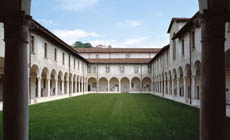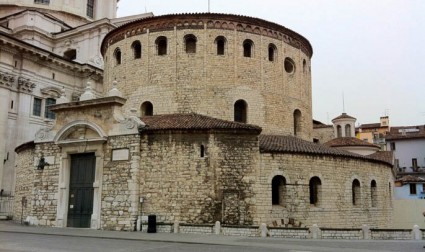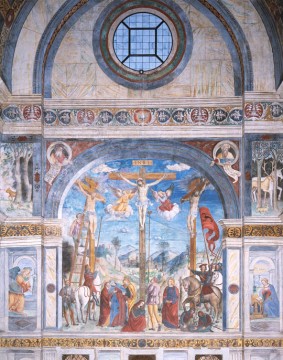 From the Roman Era we pass to the Middle Ages, or rather from piazza del Foro to via dei Musei, via dei Musei is largely flanked by one of the most impressive early Middle Ages’ buildings in north Italy, the Monastery of Santa Giulia, originally dedicated to San Salvatore. Founded by the Lombard king, Desiderius, on a site where there was once a Roman house, the monastery was continually enlarged up until the Renaissance. It was run by a community of Benedictine monks until their suppression in 1798. The Santa Giulia complex of buildings, that mirrors the history of the city from the Bronze Age to the Renaissance, houses now the City Museum which takes the visitor from the prehistoric Age, the Roman, the Lombard and the Carolingian Age and the period of the medieval Comuni and Signorie up to the Venetian Age.
From the Roman Era we pass to the Middle Ages, or rather from piazza del Foro to via dei Musei, via dei Musei is largely flanked by one of the most impressive early Middle Ages’ buildings in north Italy, the Monastery of Santa Giulia, originally dedicated to San Salvatore. Founded by the Lombard king, Desiderius, on a site where there was once a Roman house, the monastery was continually enlarged up until the Renaissance. It was run by a community of Benedictine monks until their suppression in 1798. The Santa Giulia complex of buildings, that mirrors the history of the city from the Bronze Age to the Renaissance, houses now the City Museum which takes the visitor from the prehistoric Age, the Roman, the Lombard and the Carolingian Age and the period of the medieval Comuni and Signorie up to the Venetian Age.
A part of the monastery and the Longobard church of San Salvatore date from the early Middle Ages. The church still preserves fragments of stucco and frescoes from the 11th century.
During the 12th century, the church of Santa Maria in Solario was built. Its octagonal lantern is decorated with a small loggia and small arches and can be seen from via dei Musei. The Santa Maria church was used as an oratory by the monks and was built on two floors. The upper floor is decorated with 16th century frescoes by Floriano Ferramola and others and temporarily exhibits the Santa Giulia treasure. This is a valuable collection in which three pieces in particular stand out: the Lombard Cross of Desiderius (a rare 9th century work in gold studded with cameos, gems and coloured glass and in whose centre a disk is set bearing a triple portrait from the 4th century) and the Lipsanoteca (a 4th century decorated ivory box) and Dittico di Boezio (5th century).
From the second half of the 1400’s on, the monastery was enlarged and transformed until it assumed its current renaissance style architecture. Two of these additions were the three cloisters and the nuns’ chancel in the church of S.Giulia, decorated with frescoes by Floriano Ferramola and Paolo da Caylina.
During the Middle Ages the civil and religious centre of the town moved from the Forum to what was then called piazza Mercato and what is now known as piazza Paolo VI. Around the square stand the Broletto which houses the city council administrative offices, the Duomo Vecchio and, situated between the two, the 18th c. Duomo Nuovo with its impressive façade. The Broletto is one of the most notable medieval Lombard structures and it is topped by the Tower of Pegol (the stone south face dates from the 13th c.) and has been expanded and rebuilt from time to time. It now encompasses various other buildings, including the 15th c. church of St. Augustin whose beautiful brick façade can be seen in the lane of the same name. The Duomo Vecchio (Old Cathedral), also known as the Rotonda, is one of the few round Romanesque churches in Italy. Its unusual shape was probably based on that of the Holy Sepulchre in Jerusalem. Built at the end of the 11th c., it has an attractive interior with a large circular central area surrounded by a pillared walkway. Among the masterpieces in the cathedral is the Sarcophagus of Berardo Maggi (bishop of Brescia from 1298 to 1308 who managed to bring an end to the war between the Guelphs and Ghibellines) made in red Veronese marble, and the 16th c. wooden choir stalls, pictures by Moretto, Romanino and Marone. On the rare occasions it is exhibited, the Treasure of the Holy Crosses can also be admired; it includes masterpieces in gold such as the 11th c. Stauroteca, the 15th c. Reliquary box holding a fragment of the Holy Cross, and the 11th c. banner, the Croce del Campo, which was once borne on the Carroccio.
Around the square stand the Broletto which houses the city council administrative offices, the Duomo Vecchio and, situated between the two, the 18th c. Duomo Nuovo with its impressive façade. The Broletto is one of the most notable medieval Lombard structures and it is topped by the Tower of Pegol (the stone south face dates from the 13th c.) and has been expanded and rebuilt from time to time. It now encompasses various other buildings, including the 15th c. church of St. Augustin whose beautiful brick façade can be seen in the lane of the same name. The Duomo Vecchio (Old Cathedral), also known as the Rotonda, is one of the few round Romanesque churches in Italy. Its unusual shape was probably based on that of the Holy Sepulchre in Jerusalem. Built at the end of the 11th c., it has an attractive interior with a large circular central area surrounded by a pillared walkway. Among the masterpieces in the cathedral is the Sarcophagus of Berardo Maggi (bishop of Brescia from 1298 to 1308 who managed to bring an end to the war between the Guelphs and Ghibellines) made in red Veronese marble, and the 16th c. wooden choir stalls, pictures by Moretto, Romanino and Marone. On the rare occasions it is exhibited, the Treasure of the Holy Crosses can also be admired; it includes masterpieces in gold such as the 11th c. Stauroteca, the 15th c. Reliquary box holding a fragment of the Holy Cross, and the 11th c. banner, the Croce del Campo, which was once borne on the Carroccio.
Photo: Andrew Nash

